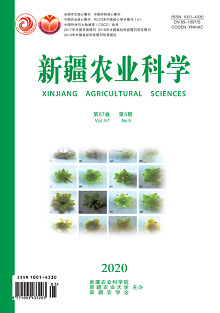|
|
Effects of the Photosynthetic and Fruit Quality of Cabernet Sauvignon on Different Rootstocks
HU Jinge, BAI Shijian, CHEN Guang, ZHAO Ronghua, CAI Junshe
2020, 57(5):
830-839.
DOI: 10.6048/j.issn.1001-4330.2020.05.006
【Objective】 To study the effect of different rootstocks on photosynthetic characteristics and fruit quality of cabernet sauvignon.【Methods】 Cabernet Sauvignon without grafting was taken as control to measure the photosynthetic active radiation, net photosynthetic rate, transpiration rate, intracellular CO2 concentration, stomatal conductivity, and during the fruit ripening stage, to measure fruit single weight, fruit volume, fruit coloring, fruit soluble solids content, pH value, acid, anthocyanin, tannin, polyphenols in pericarp, etc. of the four rootstock combinations of Cabernet Sauvignon / SO4, Cabernet Sauvignon / 5BB, Cabernet Sauvignon / 3309M and Cabernet Sauvignon / 101-14 by CI-340 Handheld photosynthesis system photosynthetic apparatus. 【Results】 The diurnal variation of net photosynthetic rate, transpiration rate and stomatal conductivity showed a typical bimodal curve with the change of air temperature. The big one of net photosynthetic rate was in the morning, the small one is was the afternoon, and the value was the smallest at 14:00. There was an obvious phenomenon of "lunch break". The peak value of stomatal conductivity in the morning was higher than that in the afternoon, and it was higher than that in the CK; The peak of transpiration rate was in the afternoon; The photosynthetic active radiation showed a single peak curve, and the diurnal variation of intracellular CO2 concentration was not obvious. The diurnal variation of intracellular CO2 concentration of Cabernet Sauvignon / SO4 and Cabernet Sauvignon/101-14 showed a pattern of “rise-fall-rise”, and the intracellular CO2 concentration of Cabernet Sauvignon / 3309 M and Cabernet Sauvignon / 5BB showed bimodal curve. The average single grain weight and fruit volume were slightly higher than those of CK. The skin color of Cabbage Sauvignon/SO4 was greener than CK,but this had little influence on average seed weight. 3309 M and 101-14 stocks increased the soluble solids of fruit, while SO4 and 5BB stocks decreased the content of soluble solids. The organic acid content of the four combinations was higher than that of CK but Ph value, solid acid ratio were lower; The anthocyanin and polyphenols content of Cabernet Sauvignon / 101-14 was higher than that of CK, while other combinations had different degrees of influence (except Cabernet Sauvignon / SO4), but there was no difference. Cabernet Sauvignon / SO4 significantly decreased anthocyanin content in pericarp. 【Conclusion】 From the point of view of photosynthetic characteristics and fruit quality, 5BB, 101 / 14, 3309M is a suitable stock variety for grafting Cabernet Sauvignon grapes in Turpan.
|

